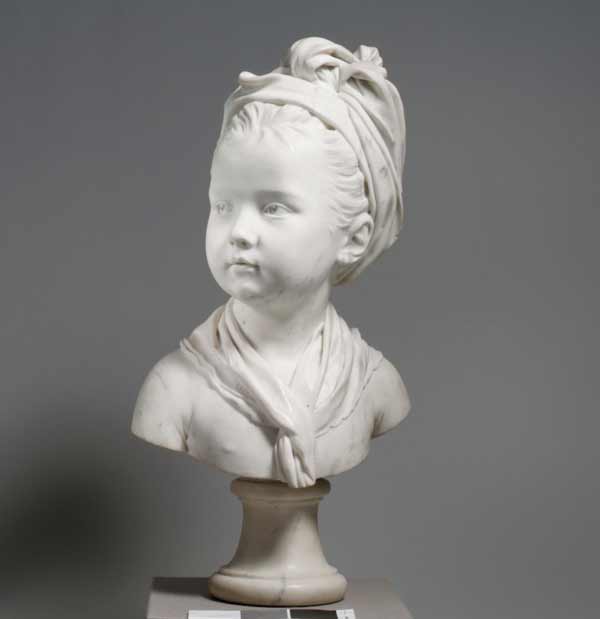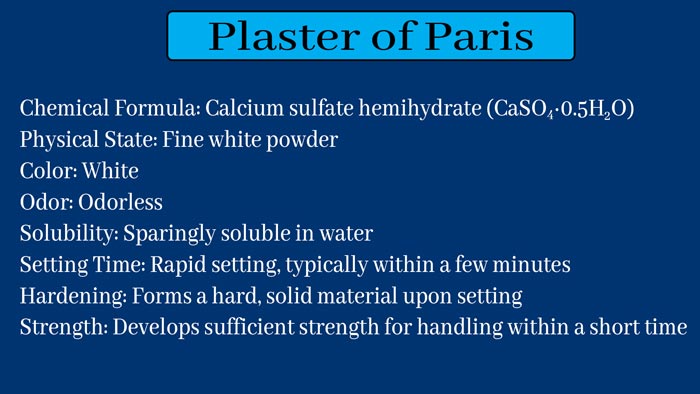What is the use of plaster of Paris?
Plaster
of Paris Properties
Plaster
of Paris, also known as calcium sulfate hemihydrate (CaSO4·0.5H2O),
has several properties that make it useful in various applications,
particularly in construction, arts and crafts, and medical fields. Here's a
list of its properties:
Chemical
Composition: Calcium sulfate hemihydrate (CaSO4·0.5H2O)
Physical
State: Fine white powder
Color:
White
Odor:
Odorless
Solubility:
Sparingly soluble in water, but it can form a paste when mixed with water.
Setting
Time: Rapid setting when mixed with water, typically within a few minutes to
several minutes.
Hardening:
Upon setting, it undergoes an exothermic reaction, transforming into a hard,
solid material.
Strength:
Develops sufficient strength for handling within a relatively short time.
Moldability:
Can be easily molded and shaped into various forms before it sets.
Adhesion:
Adheres well to a variety of surfaces, including wood, metal, and ceramics.
Versatility:
Can be used for casting molds, making sculptures, creating decorative elements,
and as a building material.
Expansion:
Exhibits a slight expansion upon setting, which helps in filling molds and
capturing fine details.
Porous
Structure: Forms a porous structure after setting, which can be advantageous
for applications such as dental casts or medical bandages.
Surface
Smoothness: After setting and drying, it typically provides a smooth surface
finish, suitable for painting or further decoration.
Biocompatibility:
Generally considered safe for medical applications such as casting broken bones
or making dental impressions.
Fire
Resistance: Exhibits good fire resistance properties, making it suitable for
fireproofing materials and coatings.
Durability:
Once set and dried, plaster of Paris can provide long-lasting stability and durability
in various applications.
Compatibility:
Can be mixed with pigments, dyes, or other additives to achieve desired colors,
textures, or properties.
Ease
of Use: Relatively easy to work with and requires minimal equipment for mixing
and application.

These
properties make plaster of Paris a versatile material widely used in
construction, art, medicine, and other industries.
The
formula of Gypsum is CaSO4.2H2O. When heated to 120°C, the Plaster of Paris is
formed. In this process, three-fourths of the crystalline water present in the
gypsum is separated.
2[CaSO4.2H2O]
→ (CaSO4)2.H2O + 3H2O
Properties
It
is a white colored powder.
Water
effect: The plaster absorbs the water and forms gypsum which hardens. This
whole action is called the solidification of plaster. This property of the
freezing of plaster is very useful.
(CaSO4)2.H2O
+ 3H2O →
2[CaSO4.2H2O]
Effect
of heat: On heating, the Plaster of Paris to 200°C, all the crystalline water
present in it is removed and the material obtained is called dead burnt.
(CaSO4)2.H2O
→ 2CaSO4 + H2O
Calcium
sulfate is reduced to calcium oxide and sulfur dioxide after heating over
400°C.
2CaSO4 → 2CaO + 2SO2 + O
What
is the use of plaster of Paris?
Plastering
is used to add broken bones in hospitals.
Blooms
and sculptures are made from Plaster of Paris.
Used
for making chalk.
Useful
in paper factories. Used to make teeth plastering.
Types
of Plaster of Paris
There
is the most common types of Plaster of Paris are Cement, Gypsum, and Lime.
